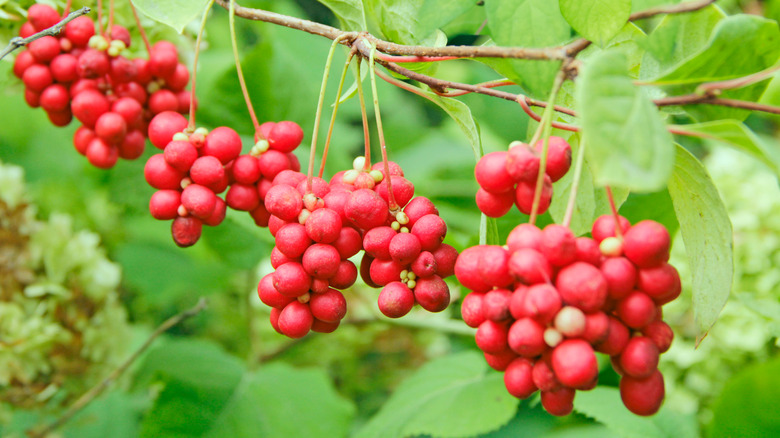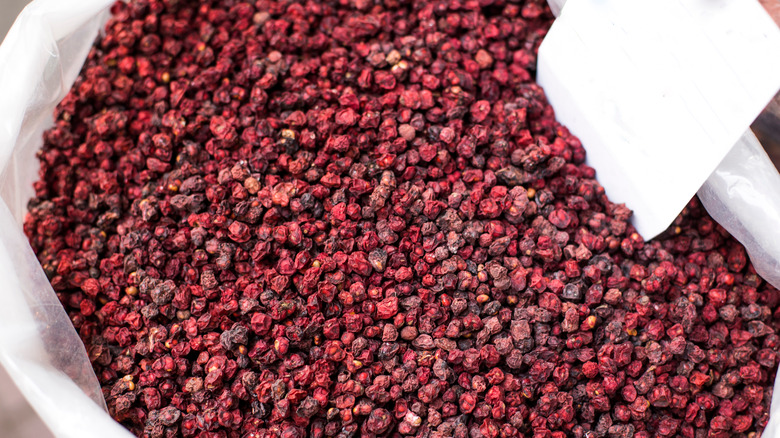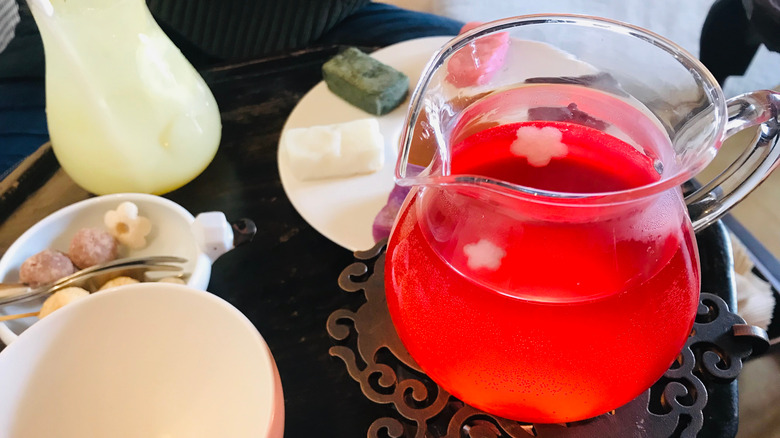Omija: The Flavorful Korean Berry You Should Know About
From tasty non-alcoholic brews and elaborate mocktails to unique iced teas like mugicha, the options for a delicious booze-less beverage are ever-expanding. In Korea, there's been a storied tradition of refreshing sober drinks for some time now. According to CNN, the country has around "200 types of traditional teas, juices, and grain drinks." A few popular varieties include nostalgia-inducing banana milk, fruity green plum tea, and the tangy omija, an ever-popular tea and punch made from berries.
The majority of these beverages involve steeping a fruit, herb, or other substance of some kind, leading to their classification as tea. Gwangju News explains that Koreans traditionally categorize teas, served either hot or cold, into four types: medicinal, fruit, grain, and leaf. As a berry, omija falls into the fruit classification. The reportedly detoxifying plant delivers an unusual mix of salty, sweet, sour, and bitter tastes — an irreplaceable medley, if you ask the Korean Herald. Bursting with flavor, hence its moniker as the "five-flavor fruit," the north Asian vine Schisandra Chinensis is something special. Let's dive into this wondrous berry.
What is omija?
As bburi kitchen notes, omija vines grow in the mountains of Korea at around 1,500 feet of elevation. The fruit resembles goji berries or small cranberries, with a vivid dark red color covered in a few dark spots. However, unlike its similar counterparts, the fruit is too pungent for raw consumption.
The berries are small — just under half an inch in diameter, and each one contains one or two small "kidney-shaped" seeds (via National Library of Medicine). Like grapes, the fruit grows in clusters and is often planted as an ornamental vine. Their native habitat extends across Northeast Asia — China, Korea, Japan, and Russia. However, through migration, omija is now also cultivated in Europe and North America too.
Part of the Schisandraceae family, omija's closest relative is the kadsura vine, which has raspberry-like berries. After a taxonomical reclassification, the fragrant star-anise shrub (one of the ingredients in Chinese five-spice) was also included in its family, reports Britannica. Just like its spice cousin, omija has a pungent flavor — perfect for a tasty beverage.
Omija is brewed into a hot or cold tea
Omija is typically diluted in warm or cold water, reports bburi kitchen — when soaked above 113 degrees Fahrenheit, the berry develops a bitter taste. The exact soaking duration varies by season, but is typically from eight to 24 hours. After this aqueous submersion, Future Dish explains that not all of the berry's five flavors come through; it's more of a sour, salty, and slightly bitter mix. To really extract the best of the berry's essence, Koreans opt for fermentation. Equal parts of sugar and fresh omija are combined in a jar, and left to ferment for a few weeks. Afterward, the extract is mixed with cold or sparkling water for a lemonade-like refreshment.
When brewing with dried berries, which are easier to find outside of Korea, it's best to leave them to soak overnight in cold water. After straining, the resultant liquid can be heated with Asian pear for a soothing, fruity tea, says My Korean Kitchen. However, due to its propensity for being overly pungent, take extra care in following brewing instructions if buying packaged tea, which tend to suggest brewing in hot water instead of cold.
Omija is regarded for its medical benefits
Omija has long been esteemed for its medicinal uses. According to the National Library of Medicine, the first mention of the berry in literature dates to 1596, when a Chinese author wrote about its usefulness against gastrointestinal problems, cardiovascular diseases, and the alleviation of fatigue. In Northeastern Russia, the vine was also consumed in order to combat energy depletion and boost "vitality." Modern research has confirmed the plant's attributes — notably its anti-inflammatory behavior and compounds that support cancer prevention and disease protection. Additionally, TeaRapha notes that omija has 17 amino acids, which means when you consume it, you're getting nearly 18% of the "essential" amino acids out there. Necessary for crucial physical processes, these compounds aid in tissue repair and protein synthesis, as well as help with digestion, per Cleveland Clinic.
This berry is truly loaded with medical qualities, but recent studies have also demonstrated omija's neurological effects. As Healthline explains, the berry may have the ability to improve symptoms of Alzheimer's and has chemicals proven useful against anxiety and depression. Being so potent, just make sure to keep consumption modest — otherwise, heartburn and gastric irritation may occur.
A delicious and refreshing berry built for tea, lemonade, and punch, look out for dried omija at Asian grocery stores. Sadly, the fresh fruit has yet to make it over to the U.S.



